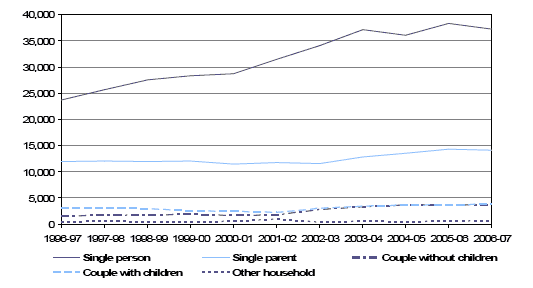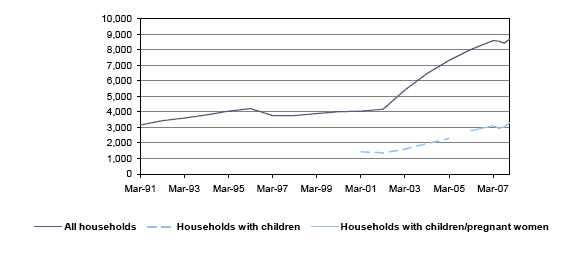Operation of the homeless persons legislation in Scotland: quarters ending 30 June and 30 September 2007 (including households in temporary accommodation at 31 December 2007)
Routine homelessness statistics update to September 2007
Main trends
7. The number of applications to councils for assistance each year under the homelessness legislation, which had remained between 40,000 and 45,000 per year in the mid to late 1990s, increased rapidly from 2000-01 to a high point of about 60,500 in 2005-06. Changes in duties to provide temporary accommodation to all those assessed as homeless and the expectation that higher proportions of applicants are likely to be assessed as priority need in order to meet the 2012 commitment are likely to have encouraged applications from households who previously would have received advice and assistance only.
8. The most recent figures indicate that this rise is levelling out with about 59,500 applications recorded for 2006-07, representing a drop of 2% over the previous year (Chart 1). This is consistent with data from previous years which have shown a slowing down of the rate of increase since 2003-04.
9. In recent years, the observed increases in levels of applications have primarily been due to the increase in the numbers of single-person households applying, with no or very little variation in applications from other household types (Chart 2). Previously published data on applications show that there has been a consistent increase since the mid-90s in the proportions of applications being assessed as being in priority need. This increase has been more marked for applications from single-person households.
10. Legislative change is likely to have been an important driver of this increase as single applicants have benefited most from the changes. However, some of the increase may also reflect wider social change in relation to the increasing number of single young heads of households in general, as well as an increase in the rate of household dissolution following breakdown of relationships.
Chart 2: Applications to local authorities under the Homeless Persons legislation by household type: 1996-97 to 2006-07

11. On the whole, recorded numbers of households in temporary accommodation have risen gradually since the early 90s, with a marked and consistent increase since 2002 (Chart 3) as councils began implementing their new duties. More recently, there has been some indication that this increase may be tapering off to some extent.
12. From March 2001, the statistics on temporary accommodation have included a separate breakdown for households with dependent children, including households with pregnant women as of June 2006 (figures from this point onward are therefore not strictly comparable with previous ones: details can be found in the notes section). The number of households with children in temporary accommodation also shows a rise since 2002, and these households currently represent about one third of all households placed in temporary accommodation.
Chart 3: Number of households in temporary accommodation in Scotland: as at 31 March 1991 to 31 December 2007

Note: Figures for households with children or pregnant women are not strictly comparable prior to June 2005 as previous figures did not include households with pregnant women and no children.
13. The statistics presented in this release relate to applications made under the legislation as well as individual households. Given the continuous nature of the recording system, figures are updated on an on-going basis and may differ from those previously published. Detailed statistical notes on the collection and presentation of this information are provided in the notes section.
There is a problem
Thanks for your feedback